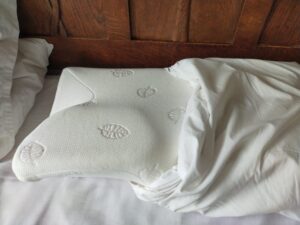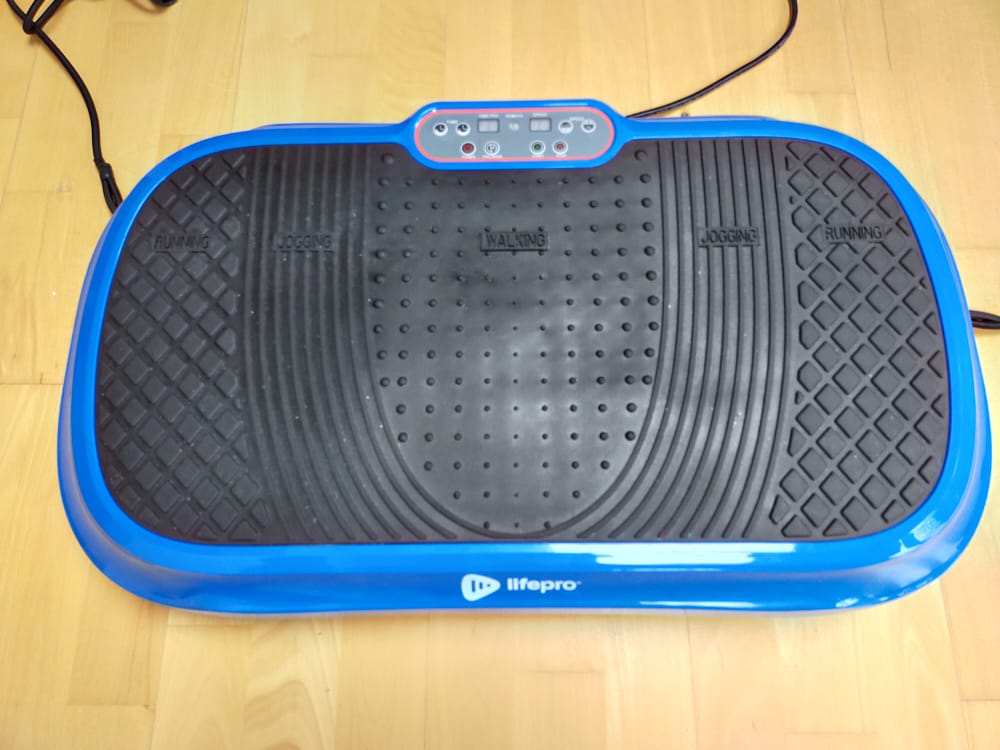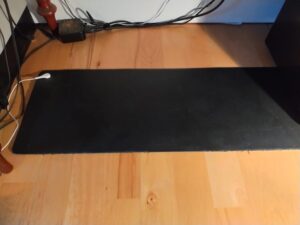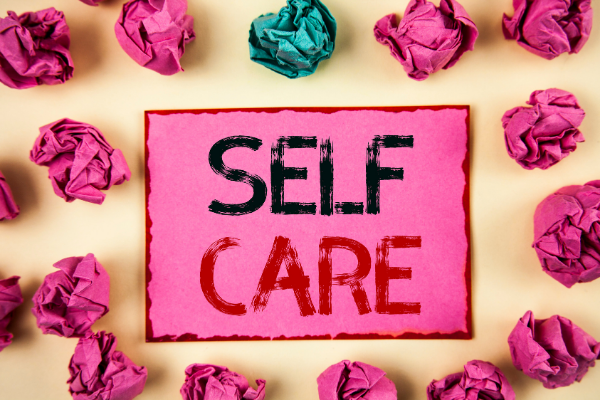
How to practise self-care as a writer
When I lose myself in writing, hours pass in the blink of an eye. Days blend into weeks, weeks into months. Because I love writing so much, and because I have an ‘all or nothing’ approach to life, there is no such thing as a weekend or a day off. The only time I take a break is when I’m forced to by my family or physical injury, or my brain goes on strike.
Many years ago I had a head injury that caused compression in my neck, and a tiny bit of bone to chip off one of my vertebrae. I also suffer from migraines, and the effects of a lifetime of poor posture, caused by growing up tall (I’m just under six foot) and wanting to be smaller. I’m the Queen of Slouch. If that wasn’t bad enough, I have spent the best part of the last thirty years in front of a computer, and now, when not, I’m likely to be bent forward over my phone.
All of which leads, unsurprisingly, to back, neck and shoulder issues. Humans didn’t evolve to spend sedentary lives, sitting down. So in order not to be crippled with pain, I have to find ways to alleviate the problems brought on by my lifestyle. Self-care for a writer isn’t just about the physical. It extends to nurturing the mind and the spirit as well. Protracted lockdowns have been particularly damaging for people’s mental health. I haven’t seen most of my close friends and family members for over a year now. Holidays with them have been cancelled, and rules, fear, and practicalities have meant that face-to-face social interactions have dwindled to nothing.
Never has it been so important to look after every aspect of my life in this current incarnation. I’m going to share some of the strategies that have worked for me and other authors in this blog. Hopefully it will help you, and also serve as a reminder that I need to practise what I preach…
Self-care for your eyes
Iris Tech
Iris Tech is the world’s best blue light filter and eye protection software, and I have it installed on my computer and phone. Iris Tech optimises screen pulsations by controlling the brightness without PWM (Pulse Width Modulation). It means I can be in front of a screen longer without headaches or migraines, and helps me sleep by regulating the amount of blue light throughout the day. If you want to read the hardcore science, then click here. Suffice to say I cannot do without this software. It actually hurts my eyes to look at my laptop or phone without it. If I need to adjust a photo for Instagram, then I can turn it off, do what I need to do, and then turn it back on again.
Iris Tech has twenty-seven different settings and can be customised or put on automatic. It is available to download for free, however I pay to have Iris and Iris mini, which covers up to five devices. Read more and check it out by clicking here.
Monitor placement
Another great tip for eye strain is to have the monitor as far away from you as possible. I have a small office and a tiny desk that used to belong to my grandmother.
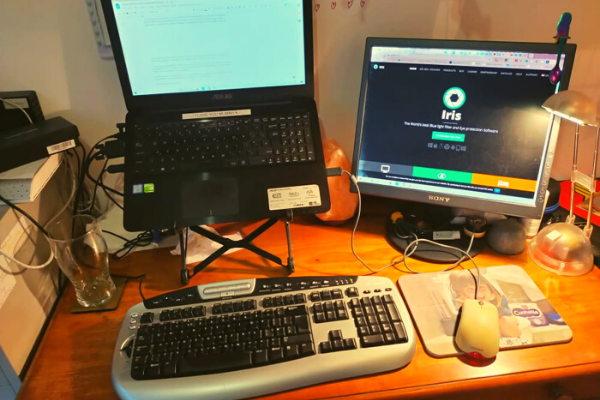
Here, I can’t get any further back… However, when I’m on writing sprints, I move to the dining table. First because there are few visual distractions, but also because it means I can have the screen further away from my eyes.
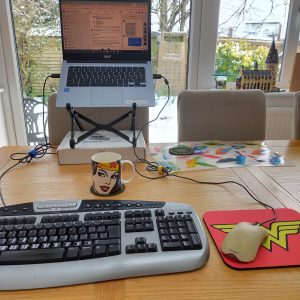
Self-care for your posture
I work at a tiny desk or the dining room table. I sit on a chair that used to belong to my grandfather, or a saggy dining chair with a pile of pillows under my bottom. Neither set up is ideal or ergonomic. Back in the summer of 2019, when I started writing in earnest, I spent many hours working with my laptop on my lap, or at tables designed for eating, not writing at. As a result, by the time I had finished the first draft of what was to become my first two books, I was crippled with pain.
It’s taken over a year of physio, massage and chiropractic work to undo the damage that was self-inflicted. As I write this, I’ve just come off another writing sprint, which has exacerbated my neck and shoulder issues. I now try to do as much as I can to ensure my posture is good when I write.
Standing desks and laptop stands

I use a stand to raise the height of my laptop, with a separate keyboard and mouse. This has helped my posture enormously, although I believe it could be improved by a different mouse that was closer to the keyboard.
Standing desks are very popular and I’ve just bought one from a friend of mine, Oliver, a furniture designer. He was inspired to create a standing desk for all the millions of people who are now working from home in unsuitable environments. His standing desk is flat-packed, can go on any flat surface, and can be easily taken apart if needed.
Karen O’Keefe Storey is a writer who has also just invested in a standing desk. She alternates between her standing desk and a regular desk to save sitting for too long, although her cat has claimed it as a new bed!
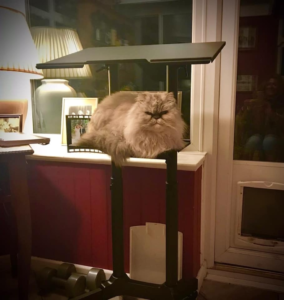
And let’s not forget Ernest Hemingway, famed for writing while standing, and who was quoted as saying, ‘Writing and travel broaden your ass if not your mind and I like to write standing up‘. So if it’s good enough for Hemingway then it’s more than good enough for me!
Neck pillows
In 2019, when I was in so much self-induced neck pain I couldn’t sleep, I bought an orthopedic neck pillow. It didn’t cure me of my pain but it was one important part of my healing process, as well as helping prevent further issues.
It looks very odd, but normal pillowcases easily fit over it, and I love it.
Self-care for your circulation
It is not uncommon for me to spend up to twelve hours a day in front of a screen. I have suffered with poor sleep for years (that’s what makes me such an expert on it), so I am often at my desk by six in the morning. If I’m not teaching yoga or breathing classes in the evening, I’ll often do a couple of hours then as well. Sometimes I feel I’m only a hundred words away from deep vein thrombosis. It’s really bad for the body to spend so long in one position, so here are some things that help with blood flow and movement of lymph.
If you don’t fancy leaving your house, here are some ideas.
Use a vibration plate
Amazing for improving bone density, increasing muscle mass, blasting fat, boosting the metabolism, blood flow and lymph, and making children laugh at you. Vibration plates are small but pack a powerful punch, achieving the same results as normal exercise within a third of the time.
Before lockdown number four-hundred-and-fifty-three, I started using one under the advice of a physio. She swears by them, and has clients using them who are very old, as well as a man who trains for body building competitions.
The one I have at home is this model. It’s easy to tuck away when I’m not using it, and I try and use it for a couple of minutes throughout the day just to keep things moving. I haven’t had it long enough yet to assess its claims to reduce cellulite, but a friend of mine says it keeps hers at bay…
Have a bounce on a rebounder
Rebounders are also great for exercise, increasing bone density, circulation and the movement of lymph. I’ve got one, but because it takes up a bit of space, and our house is small, it mainly lives under the stairs…
You also need enough height in your rooms to use it without nutting the ceiling (an issue if you’re as tall as I am). If you’re interested in a good old bounce there are models that can be folded in half and so take up less space. Check out this one here.
Get grounded with an earthing mat
Now, this may veer into the realm of woo woo for you, but stick with me… We have spent most of human evolution outside, connected to the electrical energy of the earth. We now live an insulated life, surrounded by non-native electromagnetic fields. There have been many studies indicating the damage done to our cells, which is a very large rabbit hole you can take a trip down if you are so inclined. I was introduced to the concept years ago by a building biologist. He showed us what happened to our bodies when we were connected to the earth and when we weren’t. For the last fifteen years we’ve slept on an earthing sheet, and I now have an earthing mat under my desk.
You may not feel any need for this, but if you’re interested in addressing all possible aspects of writing self-care then you might want to check it out.
And if you do fancy leaving your house…
Go for a walk
Even just walking for ten minutes has huge advantages for health, mood, and circulation. In fact a study comparing people who walked ten thousand steps a day (around five miles) with people who walked three times a day briskly for ten minutes (around one and a half miles) found that the people who walked briskly, three times a day, found it easier to achieve, and did thirty percent more ‘moderate to vigorous physical activity’ than the ten thousand step group, even though they moved for less time.
If you’ve got a dog, then this makes it even easier to achieve. Authors Katie Ginger and Florence Keeling use their pooches as the perfect excuse to leave the house, and Rosie Travers goes for a long walk every day which she also credits with alleviating writer’s block.
Change the scenery to change your mood
The phrase ‘a change is as good as a rest’ is a great way to think about giving your mind a rest from thinking about writing, and your body some activity.
Get out in nature
Walking in nature is so beneficial for our health and wellbeing that some doctors are now prescribing it. Even though it often feels like a chore to get up off my backside and leave the house, I always feel better for it.
Do some yoga
I teach yoga online, and even though I’m leading the class, it always makes me feel good. Karen O’Keefe Storey also practices yoga, and says ‘if I’ve spent several hours writing, I’ll stretch out later with a yin yoga class for twenty or thirty minutes. There are lots of good ones to follow free on YouTube.’
Enjoy a hobby
Ironically, my hobbies always seem to end up as my jobs. The spark that started my writing career came from a friend who told me I needed to do something just for me each day. Now, even though it feels like a hobby, the amount of time I spend writing means that it is actually my job. As a result, I need to find different things to do. I love cooking, so this is something that gets me away from my desk and also results in good food.
Read a book
I know this sounds like a busman’s holiday, but reading is such a joy and an inspiration to me. Finding a new author is such a treat and my idea of heaven is having nothing to do but curl up in bed with a good book.
Emotional and physical support
When we’re not in lockdown, I go to two friends for physical treatment. One is a personal trainer, massage and Emmett therapist, and the other is a gentle chiropractor and voodoo witch goddess. I credit the two of them with helping bring my body out of a state of crisis caused by too much writing with poor posture. This isn’t some kind of luxury, it’s absolutely critical to my health and wellbeing.
A writer also needs emotional support. Not just from those around them, but also from fellow writers. My support network of lovely author friends is a vital part of my self-care as a writer.
Even though it can be difficult to put ourselves first, self-care means we are able to be our best selves and deal with everything that life throws at us. The author Katie Ginger is a wonderful example of someone who makes sure she schedules time to look after herself.
I’m scheduling one act of self-care a week. A body scrub, a hair mask etc and it’s really been working. Physically, I walk the dogs but I love Les Mills On Demand and do a mix of yoga, body combat, body pump and core each week.
Whether you treat yourself to a long soak in the tub, find time for some art, or simply spend another hour in bed. Looking after yourself has benefits for you, your writing, and everyone around you.
What do you do for self-care? Fancy trying any of my ideas above? Let me know via email or social media!
Evie X
